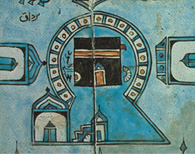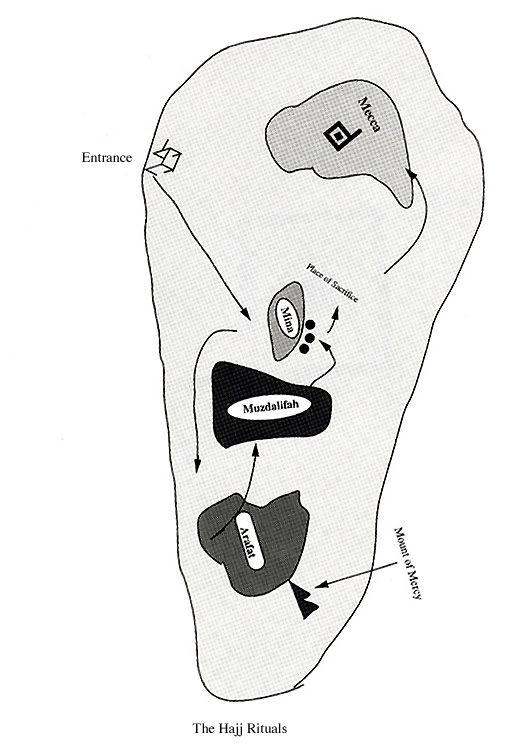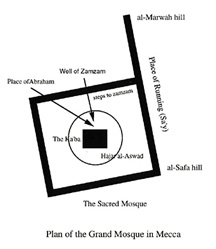 |
A Brief Note on the Hajj Rituals
By Iraj Bashiri Copyright, Iraj Bashiri, 2004 |
The Muslim religious pilgrimage to Mecca, known as the hajj, satisfies the fifth and last pillar of the faith. Every Muslim who is healthy and sane and who can afford it must undertake the pilgrimage to Mecca at least once in his or her lifetime. The pilgrimage consists of a series of rites performed in around the city of Mecca, Saudi Arabia. The rituals of the hajj are perfumed between the 8th and the 13th days of the 12th month (Dhul Hajjah) of the lunar calendar. While some of the rituals, like 'Arafat, must be performed at a particular time, certain others, like shaving the head or offering sacrifice, can be done over a longer period, mostly towards the end of the rituals.
Putting on the ihram (obligatory)
The ihram is a white, seamless garment. It consists of two pieces for men and one piece, a simple white gown, for women. It is the only garment that the pilgrim is allowed to wear during the performance of the hajj rituals. At the time of his or her entrance to Mecca, the pilgrim must already be clothed in the ihram. Some pilgrims don their ihram in Medina, some in Jeddah and some others in the neighboring towns to the east and south of Mecca. Hajj etiquette dictates that the pilgrim must not wear any jewelry and that no violent or sexual acts should take place during the entire length of the rituals.
Putting on the ihram is accompanied by a total change of attitude that is a result of the pilgrim's intent (niyyah) to renounce the world for a more pious and humble life.
Entering the Haram
The haram, an area of about three miles in width and eighteen miles in length, around the city of Mecca, is set aside for the rites of the hajj. Clad in ihram, the pilgrim enters the sacred haram and formally declares his or her devotion by repeatedly uttering the Talbiyah: "Doubly at Your service, O God."
 |
Proceeding to Mina
The rituals begin on the 8th day of Dhul Hajjah as the pilgrim walking, riding a bus or a truck, proceeds in the direction of the small village of Mina located about five miles east of Mecca. At Mina, the pilgrim spends the first day of the rituals resting and making preparation for the hardest of the rites, that of standing at 'Arafat. The stay is in keeping with the Prophet's example, when he performed his last pilgrimage and spent the night at Mina.
Standing on the Plain of 'Arafat (obligatory)
On the morning of the 9th of Dhul Hajjah, the pilgrim arrives on the Plain of 'Arafat. Here, facing Mecca, the pilgrim spends the entire second day of the ritual standing, meditating, and praying. The rest in Mina helps the pilgrim pull through the rigors of 'Arafat, especially when the time of the rituals coincides with the peak of summer heat. There is, however, no strict rule that the pilgrim must stand. Some pilgrims sit, talk, and eat. Some others climb the Mount of Mercy, which is located to the southeast of the plain. The Mount of Mercy is the mountain at the foot of which the Prophet stood and delivered his farewell sermon. It should be noted that the normal prayers are shortened and combined with other related prayers.
At Muzdalifah
After sunset, a cannon fired ceremonially, signals that the pilgrim must begin the journey back to Mina. The pilgrim is to stay at Muzdalifah for more worship and rest. The next day, before leaving Muzdalifah, the pilgrim gathers 49 pebbles and carries them with. Some more cautious pilgrims pick up 70 pebbles. The pebbles are thrown at the Devil at specific points in the ritual. 49 pebbles would be sufficient, if the tawaf can be performed according to schedule. Every time that the tawaf is postponed, more pebbles must be used at Mina, before performing the tawaf (more details below). |
The Three Pillars
The 10th day of Dhul Hajjah begins before daybreak. The pilgrim moves on to the village of Mina. There are three white pillars at Mina representing "the Great Devil." On this third day of rituals , the pilgrim throws seven of the pebbles at the Jamrat-ul-Aqabah. The pillars at Mina, it should be added, mark the place where the Devil made three attempts at persuading Abraham to disobey God's command and not sacrifice his son, Isaac, and failed.
The Sacrifice Ritual
Each pilgrim buys a sheep or a goat and gives its meat away to the poor. Those who cannot afford to sacrifice a sheep or a goat buy a portion of meat and give that away. The sacrifice is an offering to thank God for his generosity and blessings. It also allows those who are more fortunate to share their wealth with those less fortunate. More importantly, it testifies that, like Abraham who was willing to sacrifice his son, the pilgrim is willing to give up all worldly desires. Since all Muslims, wherever they might be, perform the sacrifice ritual at this same time, the ritual of sacrifice at Mecca creates a special bond among all Muslims. In other words, through the ritual of the sacrifice, the hajj pilgrim gives Islam its special sense of international understanding and solidarity.
Taking off the ihram
The pilgrim has been wearing the ihram since before entering Mecca. Now the ihram is removed. Men shave their hair while women cut off a symbolic lock for deconsecration. Everyone bathes, puts on new clothes, and gets ready for performing the tawaf or circumambulation around the Ka'ba (cube).
Before performing the tawaf, the pilgrim throws seven pebbles at each of the three pillars, starting with the first, small pillar, followed by the middle pillar and, finally, at the Jamrat-ul-Aqabah.
The tawaf, which must be performed before the sunset on the 12th of Dhul Hajjah, is not easy to perform. One million pilgrims must stand in front of the black stone and begin their circumambulations. Taking turns, it may take one, two, or even three days before a pilgrim can perform the tawaf. Each day, before going to perform the tawaf, the pilgrim must throw 21 pebbles at the three pillars. That's why some pilgrims bring 70, rather than the required 49, pebbles from Muzdalifah.
Making the Tawaf (obligatory)
At the Sacred Mosque that encloses the Ka'ba (cube), the pilgrim positions himself or herself in front of the Black Stone (Hajar al-Aswad). From that position, he or she circumambulates the Ka'ba seven times, all the time reciting prayers.
|
 |
Kissing the Hajar al-Aswad
While circling the Ka'ba, following the example of the Prophet, the pilgrim tries to get close to the Black Stone and, if possible, touch or kiss it. After the tawaf is complete, the pilgrim goes to the Place of Abraham, i.e., the place where Abraham stood and worshiped God.
Making the Sa'y
After the seventh circumambulation, the rituals of the hajj are complete. But there is still one more place to visit: the Place of the Running. At this place there are two hillocks, one at some distance from the other. The hillock farthest from the Ka'ba is called al-Marwah. The other is called al-Safa. The pilgrim walks briskly (seven times) between al-Safa and al-Marwah in commemoration of Hagar's frantic search for water for her infant son, Isma'il. Hagar, Abraham's wife, was abandoned by her husband in the desert near the present site of the city of Mecca. Tradition has it that Gabriel appeared to Hagar, stamped his heel and produced a spring of fresh water for the mother and the infant to drink. That spring, called Zamzam, still runs and refurbishes the Zamzam well. All pilgrims, before they depart, drink from Well of Zamzam.